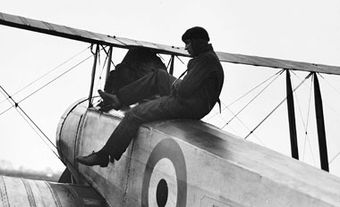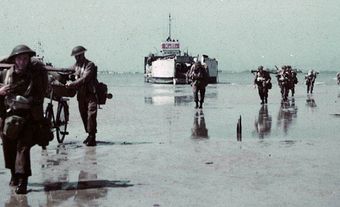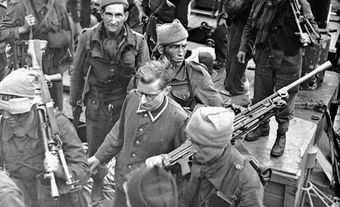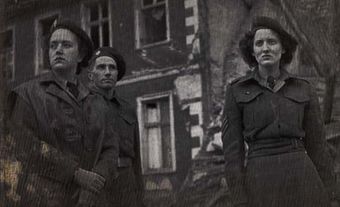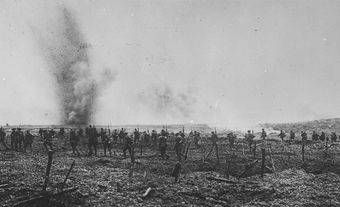Joseph Lionel Elphege Albert de Niverville, pilot (born 31 August 1897 in Montreal, QC; died 14 June 1968 in Montreal, QC). During the First World War, de Niverville served in the Royal Air Force (RAF). He also served during the Second World War and was one of the few French-Canadian officers in the Royal Canadian Air Force (RCAF) at the time. He rose to the rank of air vice-marshal, the first French Canadian to do so.
Early Life
Born in Montreal, de Niverville moved with his family to Ottawa while in his youth. He was educated at St. Peter Public School and La Salle Academy.
First World War
On 2 April 1917, de Niverville enlisted in the Royal Flying Corps. Passing his flying training, he was made Temporary 2nd Lieutenant in June 1917 and confirmed as 2nd Lieutenant on 2 February 1918. He was promoted to Lieutenant that same date. He served with No. 42 Squadron of the Royal Air Force, flying Royal Aircraft Factory RE-8 two-seat bi-plane reconnaissance and bomber aircraft. While on an artillery observation mission on 7 July 1918, de Niverville was wounded in the left arm by machine-gun fire from the ground. His observer was unharmed. After initial admission to 14 General Hospital, Wimereux, he was sent back to the United Kingdom to recuperate and became an instructor. In April 1919, he returned to Canada and was discharged.
Inter-war Period
When the Canadian Air Force (CAF) began to accept enlistments on 18 February 1920, de Niverville enlisted as a flying officer in the air reserve. Subsequently, he was employed as a civilian pilot by the Air Board and as a military pilot by the CAF. In 1922 he was employed in Ottawa.
When the Royal Canadian Air Force (RCAF) was formed on 1 April 1924, de Niverville was appointed to the permanent force and posted to Camp Borden as flying officer and instructor at No. 1 Flying Training School. De Niverville attended the photographic course and the air pilotage course that ran concurrently between 4 January and 17 February 1927.
On 1 May 1927, de Niverville was posted to the aircraft inspection detachment in Montreal. Here he was attached to Canadian Vickers Aircraft Ltd, inspecting their work. His time and service there were limited, however, and De Niverville was temporarily sent to Camp Borden as flying operations officer on 29 May.
On 7 September 1927, de Niverville was posted to RCAF HQ in Ottawa as staff officer. This came with promotion to flight lieutenant while so employed. The rank was confirmed on 1 April 1928. One of his duties was to help select pilots for the RCAF from amongst candidates of The Royal Military College of Canada and university graduates. He was also asked, along with two other RCAF officers, to judge the Montréal Light Aeroplane Club’s annual skills competition. This request reflected the close relationship between the RCAF and civilian flying clubs.
De Niverville was one of the few French-speaking officers in the RCAF. In January 1931 he wrote the British civil service interpreters’ exam. He had highest marks of anyone taking the exam in 20 years. He also passed the RAF Staff College admissions examinations that same month.
On 30 April 1931, de Niverville was posted to RCAF Station Jericho Beach, just outside Vancouver. He was the adjutant as well as a seaplane and floatplane instructor. De Niverville was one of the pilots involved in the opening of new airports in Chilliwack and Vernon, British Columbia.
The Jericho Beach posting did not last long. He was sent to RCAF Station Rockcliffe in Ottawa on 1 March 1932, at the same time being detailed for employment with the Directorate, Civil Government Air Operations. On 20 March, along with other pilots, de Niverville was attached to the Belle Isle detachment. The Post Office and the Department of National Defence had recommended an experimental air mail service between Belle Isle and Montreal for the two months that the Imperial Economic Conference was being held in Ottawa. Between 20 June and 31 August, he made 17 flights between Belle Isle and Rimouski, Quebec, before returning to Ottawa on 2 September. These flights met an incoming passenger liner and transferred mail to the aircraft, thereby cutting three days’ time off the mail service.
De Niverville was transferred to England to attend the RAF Staff College course in December 1932 and took his family with him. He passed the course and, in early January 1934, was back in Canada. He was promptly posted to an administrative position at RCAF HQ as assistant staff officer, air staff duties.
In 1934, when the RCAF began creating Non-Permanent squadrons (air reserve), it also created positions within various Military Districts for an air staff officer (ASO) to provide advice for the officer commanding the district. With Nos. 15 and 18 Squadrons formed in Montreal in 1934, de Niverville was posted to Military District (MD) 4 in Montreal, effective 15 January 1936. This came with a promotion to squadron leader.
Among de Niverville’s activities as ASO was intelligence officer at MD 4. He also consulted with the squadrons in Montreal and participated in their events. On 16 February 1939, de Niverville was posted to RCAF HQ and was promoted to wing commander. His new position was as air member for organization.

Second World War
As Director of Air Organization, one of de Niverville’s duties was to oversee the formation of new units as the RCAF expanded. This included the new units of the British Commonwealth Air Training Plan (BCATP). In support of this role, de Niverville, along with two other senior officers went to the United Kingdom from February to March 1940. There they studied the RAF’s training methods and organization. Their subsequent report helped organize the BCATP.
On return from overseas, de Niverville became Director Air Force Manning serving in that position from 1 May 1940 to 8 August 1941. The position came with a promotion to Group Captain on 28 September 1940. Among his responsibilities was recruiting. In support of this he initiated the policy of bringing home aircrew who had distinguished themselves. They would then conduct tours to support the war effort.
After a brief stint as commanding officer of No. 2 Service Flying Training School (9 August to 7 September 1941) at RCAF Station Uplands in Ottawa, de Niverville was appointed Air Officer Commanding No. 3 Training Command in Montreal. He served in this position from 20 October 1941 to 20 November 1943. He was promoted twice, first to air commodore, and then to air vice-marshal on 14 December 1942.
In all of these positions, de Niverville was able to indulge his love of flying. He flew his own plane on his visits to schools and to other formations, logging 140 hours in the two years to December 1942 as first or second pilot.
When Air Vice-Marshal Robert Leckie vacated the position of air member for training, prior to becoming chief of the air staff, de Niverville replaced him on 22 November 1943. He remained in this position until his retirement on 11 February 1946.
Military Recognition
Air Vice-Marshal de Niverville’s work in the RCAF received recognition on several fronts:
- Honorary degree, Doctorate of Law, University of Ottawa (1943)
- Commendation for Valuable Service in the Air, bestowed by King George VI (1944)
- Companion of the Most Honorable Order of Bath (1944)
- Commander Legion of Merit (United States) (1946)
- Order of the White Lion, Class II (Czechoslovakia) (1946)
- Officer of the Légion d'honneur (France) (1947)
- French Croix de guerre avec une palme de bronze (1947)
Two streets have been named after him. There is a de Niverville Private in Ottawa in the former military housing at Ottawa International Airport and a Boulevard Albert de Niverville at Montreal’s Trudeau International Airport.

Retirement
On retirement de Niverville appeared at some RCAF events, such as dinners and funerals. His main focus turned to the Department of Transport. He started as District Controller of Air Services, rising to the position of Assistant Deputy Minister, Air. He retired in November 1964 and died in Montreal on 14 June 1968.
Family
On 8 September 1920, de Niverville married Eméla Noël and together they had 13 children (ten boys, three girls). His son Joseph Albert Hector Gilles served in the RCAF during the Second World War and died in the crash of a Lockheed T-33 in July 1954. His son Louis was a noted Canadian modernist artist.
Significance
There were very few French-Canadian officers in the RCAF from 1924 to 1939. As a result, de Niverville was the first to achieve all the ranks from wing commander to air vice-marshal. As commanding officer of two manning depots in Quebec, as the Director of Air Force Manning, and as a highly visible senior RCAF officer, he likely had an influence in the recruiting of French Canadians into the RCAF.

 Share on Facebook
Share on Facebook Share on X
Share on X Share by Email
Share by Email Share on Google Classroom
Share on Google Classroom





